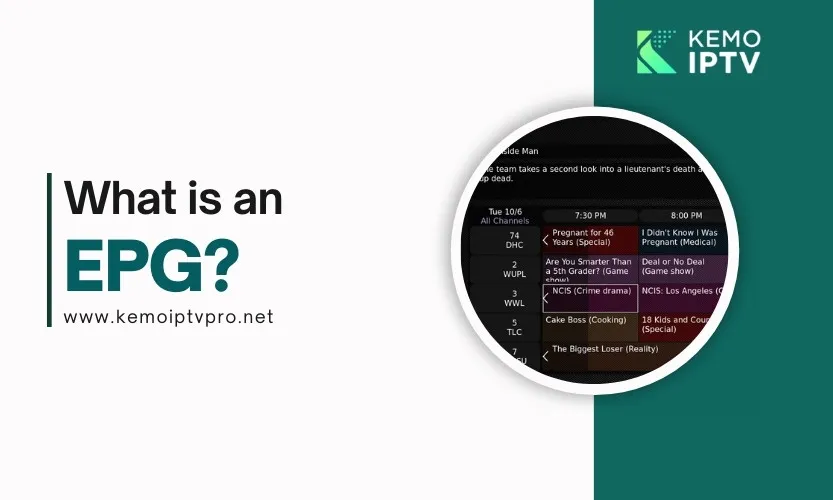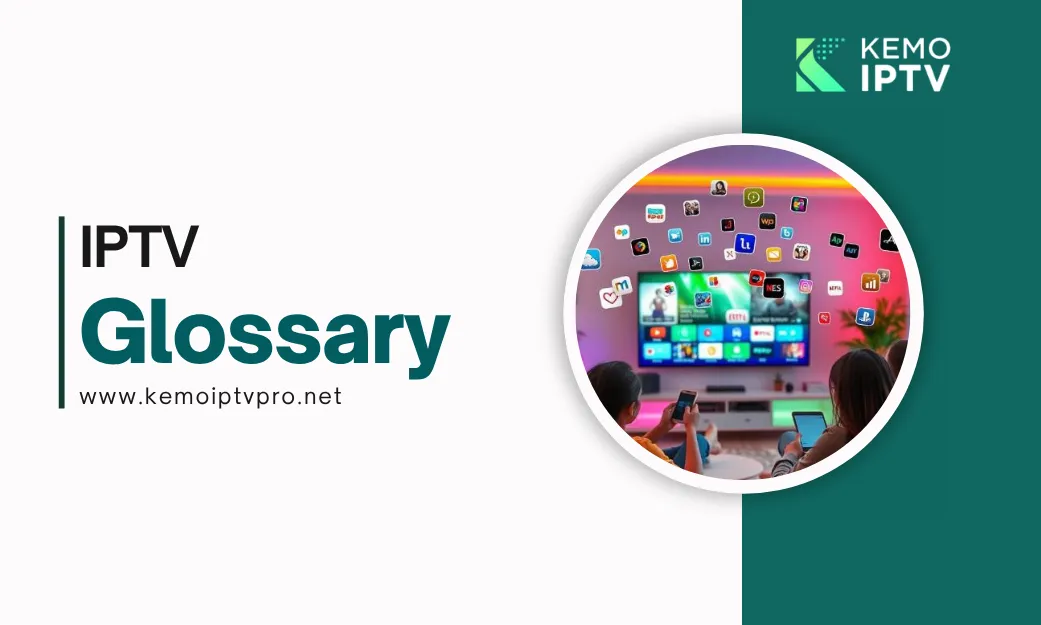You settle onto your couch, ready to unwind with some TV. You grab the remote and pull up that familiar grid of channels and show times—scrolling through options, checking what’s on now and what’s coming up later. That digital schedule you’re browsing? That’s an Electronic Program Guide, or EPG.
An EPG is essentially your on-screen TV guide—a menu-based software application that displays what’s currently playing, what’s coming up next, and detailed information about each program across all available channels. According to Ofcom, it’s the digital tool that helps viewers “navigate to different channels and programmes” from their TV or device. For millions of viewers, the EPG is the first place they turn when deciding what to watch.
This matters more than you might think. With hundreds of channels and thousands of streaming options available today, finding something to watch has become overwhelming. Research from Gracenote reveals that over 84% of viewers in North America and the UK don’t know exactly what they want to watch when they start a streaming session. In this landscape of content abundance, the EPG serves as your navigator through the chaos—organizing options, surfacing recommendations, and helping you make decisions without the frustration of endless scrolling.
In this article, we’ll explore how EPGs work behind the scenes, the features that make them essential, their evolution from printed TV guides to AI-powered discovery tools, and what the future holds for this cornerstone of the television experience.
How Does an EPG Work?
The Data Behind the Guide
An EPG isn’t magic—it’s powered by program metadata. TV networks, broadcasters, and content providers continuously supply detailed schedule data including program titles, air times, episode descriptions, genres, cast information, and parental ratings. This information is collected and aggregated by specialized providers like Nielsen’s Gracenote or directly from broadcasters, then distributed to your device.
The metadata can arrive in several ways: embedded directly within broadcast signals (common in traditional cable and satellite TV), delivered via internet APIs for streaming platforms, or transmitted through standardized formats like XMLTV for IPTV systems. This data infrastructure is surprisingly complex—ensuring that millions of viewers across different devices all see accurate, synchronized schedule information requires robust backend systems.
Real-Time Updates Keep It Current
What makes modern EPGs truly valuable is their ability to update in real-time. If a football game runs into overtime, breaking news preempts scheduled programming, or a network adds a last-minute special, the EPG needs to reflect those changes immediately. According to Fastpix, this is especially critical for live news and sports broadcasting—if a major event isn’t listed correctly in the EPG, viewers might miss it entirely, representing a lost opportunity for both audiences and broadcasters.
Today’s EPG systems use cloud-based services or APIs directly linked to broadcasters’ scheduling and newsroom systems, pushing updates instantly as changes occur. This ensures that the guide you’re looking at right now is as accurate as possible.
Interface Generation: From Data to Display
Your device—whether it’s a cable box, smart TV, streaming app, or set-top box—receives this structured schedule data and transforms it into the visual interface you interact with. The most common layout is the grid interface: channels listed vertically, time slots running horizontally, with program titles filling each cell. This design has become the industry standard because it provides an intuitive, at-a-glance overview of what’s available across the entire schedule.
Users can typically page through 7 to 14 days of listings, jumping forward to see what’s coming up or backward to access catch-up content. The software rendering this interface is platform-specific—an Apple TV handles it differently than a Roku or Samsung smart TV—but the underlying data structure remains consistent.
Key Features of Modern EPGs
Today’s EPGs are far more than passive schedules. They’re interactive discovery engines packed with features designed to enhance your viewing experience.
Interactive Navigation and Search
Modern EPGs allow you to search for specific shows by title, actor, or keyword—invaluable when navigating hundreds of channels. Filter options let you narrow listings by genre (showing only movies, sports, or news), content rating, HD availability, or language. This targeted browsing dramatically reduces the time spent hunting for something specific.
When you select a program listing, detailed information expands: full synopsis, episode number, cast list, director, runtime, and maturity rating. This metadata helps you make informed decisions without having to sample random shows.
Personalization and Recommendations
Taking a cue from streaming giants like Netflix, modern EPGs now incorporate AI-driven personalization. By analyzing your viewing history and preferences, the guide can surface tailored content recommendations—even within the traditional channel grid. Some systems create custom “favorite channels” lists or support multiple user profiles so each household member gets relevant suggestions.
DVR Integration and Reminders
One of the most valuable features is seamless DVR (Digital Video Recorder) integration. With a single button press from the EPG, you can schedule recordings of individual episodes or entire series. No more programming complex timers manually. You can also set reminders for upcoming shows, ensuring you never miss your favorites.
Time-Shifting and Catch-Up TV
Many EPGs now integrate with catch-up TV services, allowing you to browse backward past the current time to find and watch programs that already aired. This “time-shifting” capability—pausing, rewinding, and replaying live television—gives viewers unprecedented control over their schedules. The EPG becomes the gateway to both live and recently-aired content, all in one unified interface.
Cross-Platform Synchronization
Modern EPGs sync across devices. You might browse the guide on your phone during your commute, set a recording, and find it waiting on your TV at home. This multi-device ecosystem—spanning televisions, web browsers, tablets, and smartphones—ensures you can manage your viewing experience from anywhere.
Benefits of EPGs: Why They Matter
For Viewers: Combating Decision Fatigue
The primary value of an EPG is bringing order to content overload. According to Gracenote, content discovery remains “one of the largest challenges” in streaming, with vast libraries containing hundreds of thousands of titles. Without an organized guide, finding something to watch becomes exhausting.
EPGs cut through this noise by providing a complete, structured menu of what’s available. Instead of blindly channel-surfing or scrolling endlessly, you have a clear roadmap. The guide also facilitates content discovery—introducing you to shows or channels you might not have been actively seeking. That documentary you stumbled upon while browsing the guide? That’s the EPG doing its job.
Features like reminders and DVR scheduling transform the EPG into your personal TV planner, helping you never miss must-watch content while maintaining control over when and how you watch.
For Broadcasters and Providers: Engagement and Revenue
From the provider perspective, a quality EPG is fundamental to viewer retention. Platforms with confusing, inaccurate, or outdated guides risk high churn rates as frustrated users abandon the service. Conversely, an intuitive, feature-rich guide keeps viewers engaged longer, increases total watch time, and builds platform loyalty.
EPGs also unlock monetization opportunities. Providers can sell premium, highlighted slots within the guide to promote new series or movies. In ad-supported environments, banner ads within the EPG interface or targeted advertising based on guide interaction data generate additional revenue. According to industry analysis, the EPG has evolved from a simple utility into a strategic asset for driving business metrics.
The market reflects this importance: the global EPG data services market was valued at approximately $1.25 billion in 2024 and is projected to reach $3.45 billion by 2033, growing at nearly 12% annually. This growth is fueled by the explosion of digital content and connected devices.
A Brief History: From Print to Pixels
The Print Era
Before digital guides, viewers relied on printed TV schedules. TV Guide magazine, founded in 1948 and launched nationally in 1953, dominated this space for decades. Its signature “log” format—organizing programs by start time and channel—established a user interface paradigm that would influence digital guides for generations.
The First On-Screen Guides
The first true EPG in North America launched in 1981 by United Video Satellite Group (UVSG). This early version was a dedicated 24-hour channel that slowly scrolled upcoming shows—typically displaying about 90 minutes of programming ahead. It was non-interactive; viewers had to tune to that specific channel and wait for their desired information to scroll by. Later rebranded as the Prevue Guide and eventually TV Guide Channel, it added advertisements and background music to its listings.
The Interactive Revolution
The 1990s brought a paradigm shift. As cable systems expanded to offer hundreds of channels, the scrolling guide became impractical. Companies like StarSight Telecast pioneered the Interactive Program Guide (IPG) in 1994, allowing users to navigate a grid-based menu non-linearly with a remote control. This innovation introduced program search, descriptive synopses, one-touch recording, and DVR control—fundamentally changing how viewers interacted with television.
By the 2000s, the IPG had become standard across virtually all digital TV receivers and set-top boxes. The technology continued evolving, expanding to smart TVs and mobile applications, creating a multi-device ecosystem.
EPG in the Age of Streaming and OTT
The television landscape is undergoing a fundamental shift toward streaming—and EPGs are adapting accordingly. As of 2024-2025, streaming platforms command over 46% of total television viewing time in the U.S., surpassing both cable and broadcast combined. With an estimated 88-90% of U.S. households now owning Connected TV devices, the EPG experience on smart TVs and streaming apps has become primary, not secondary.
The FAST Channel Boom
A key driver has been the explosion of Free Ad-Supported Streaming TV (FAST) services like Pluto TV, Tubi, and The Roku Channel, which collectively reach over 111 million viewers monthly in the U.S. These platforms recreate the “lean-back” channel-surfing experience that viewers still crave—and the EPG is central to that experience.
However, FAST requires a more agile EPG architecture than traditional broadcast. Channels can be added or removed on the fly, schedules change within minutes, and ads are inserted programmatically. This demands cloud-managed, API-driven systems capable of real-time updates.
Hybrid Guides: Blending Live and On-Demand
Modern streaming EPGs often merge live schedules with on-demand libraries, creating a unified content hub. You might see a live news broadcast alongside links to replay earlier segments, or a grid showing both upcoming linear programming and VOD recommendations. This convergence breaks down traditional silos between content types.
The streaming environment also enables powerful personalization since platforms know user preferences and viewing history. Your EPG can highlight channels you favor, recommend trending live events, or surface content based on time-of-day patterns.
Future Trends in EPG Technology
AI-Powered Intelligence
The next generation of EPGs will leverage artificial intelligence for predictive personalization. Beyond simple “viewers who watched X also watched Y” recommendations, advanced machine learning will analyze your habits, time patterns, and contextual signals to proactively surface content you’re likely to want—often before you search for it. According to market analysis, AI-driven discovery is critical for solving content navigation at scale.
Voice Control and Conversational Interfaces
Voice interaction is rapidly becoming standard. Instead of manually navigating menus, you can ask your voice remote or smart speaker: “What’s on HBO at 9 PM?” or “Find comedy movies starting soon.” The EPG processes natural language queries and delivers results instantly, creating a more intuitive, hands-free experience—particularly valuable for accessibility.
Cross-Platform Integration
Future EPGs may aggregate content from multiple streaming services and live channels into one unified guide, eliminating the need to check each app separately. Universal search could show you where a specific show is available—whether it’s airing live on cable, available on-demand, or streaming on Netflix.
Accessibility Improvements
Regulatory pushes, particularly in markets like the UK, are mandating EPG accessibility features: text-to-speech for visually impaired users, high-contrast display options, and improved navigation for those with disabilities. These inclusive design principles will become standard globally.
Conclusion: Your Gateway to the Content Universe
The Electronic Program Guide has transformed from a simple scrolling schedule into an intelligent, interactive gateway to entertainment. It started as a practical necessity—helping viewers navigate expanding channel lineups—but has evolved into a strategic platform that shapes how we discover and consume content.
Even as viewing habits shift toward on-demand and algorithmic recommendations, the EPG remains vital. Whether you’re finding what’s live right now, scheduling recordings for later, or exploring new shows you didn’t know existed, the guide serves as your personal content navigator.
As entertainment options continue multiplying, EPGs will become smarter, more personalized, and more seamlessly integrated across devices. But their core mission stays constant: helping you find something great to watch—without the frustration of endless searching. The next time you browse your TV guide, remember: you’re using technology that’s continuously evolving to make your entertainment experience better, one program listing at a time.




